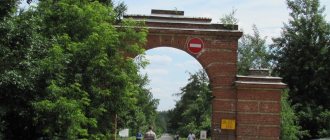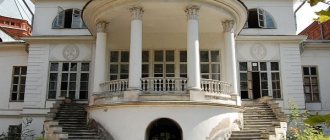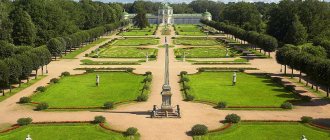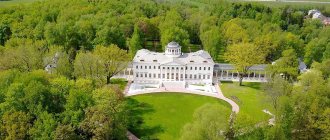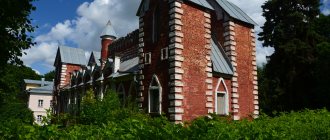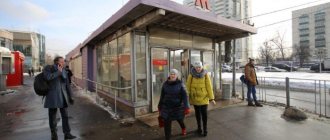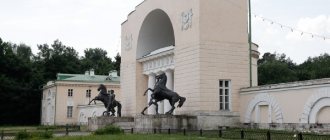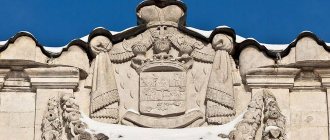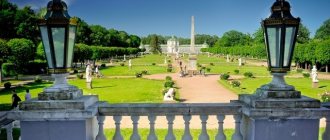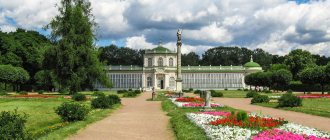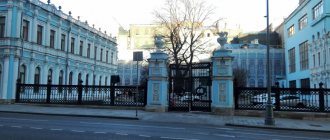History of the estate
The owners of the Bratsevo estate were many famous aristocratic families: the Naryshkins, Stroganovs, Apraksins, Vyazemskys, Rimsky-Korsakov and others. For several summer months, the artist Shishkin I, then unknown to anyone, worked here. It was his stay in these picturesque places that allowed him to be inspired and complete the painting “Midday. Neighborhoods of Moscow", which brought young Shishkin his first fame.
A romantic history of the early 20th century is connected with the Bratsevo estate. Count A. Stroganov married Ekaterina Trubetskoy. This was his second marriage, and it ended in disaster - almost immediately after the birth of their joint child, the Countess fell passionately in love with Adjutant General Rimsky-Korsakov, a retired favorite of Catherine II herself. He was an outstanding person, but the countess was famous not only for her beauty, she was very smart and extraordinary, and the brave adjutant general also became seriously interested in her. The romance flared up with such force that the countess decides, despite the condemnation of the world, to leave her husband and go to her beloved. In those years it was a courageous act, but Count Stroganov also behaved very nobly. He did not take revenge on Catherine, let his wife go and even gave her the Bratsevo estate so that she could live there away from the world. There she lived with her common-law husband until her death.
The last owner of the Bratsevo estate was N. Shcherbatov, who himself handed it over to the state after the revolution. The only thing he asked for was the status of a cultural and historical monument for the estate, so that a unique place could be preserved for descendants.
History of the estate complex
Mentions of the first buildings on the site of the estate date back to the 17th century. In the 1650s, the village of Bratsevo came into the possession of the boyar Bogdan Khitrovo. Under him, in the 1660-1670s, the Church of the Intercession of the Blessed Virgin Mary was erected and a boyar courtyard with economic buildings was erected.
Bratsevo - noble estate of the Stroganovs of the 18th–19th centuries. in Moscow
After the death of Khitrovo and his heirs, Bratsevo passed to the boyar Kirill Naryshkin. In 1780, Count Alexander Stroganov acquired the estate as compensation for his wife Ekaterina Trubetskoy.
Ekaterina Trubetskaya lived in Bratsevo in a civil marriage with Adjutant General Ivan Rimsky-Korsakov, a former favorite of Empress Catherine II. As of 1800, the couple occupied the manor's wooden house.
According to one version, in 1813-1815, a stone mansion building was erected on the site of a house that burned down during World War II. The English park with the decorative rotunda gazebo “Milovid”, a stone bridge and a cascade of ponds dates back to approximately the same period.
After the death of Ekaterina Trubetskoy in 1815, the estate was inherited by Rimsky-Korsakov. In 1828, he gave Bratsevo to his illegitimate son from Trubetskoy, Colonel Vasily Ladomirsky. After his death in 1847, the estate passed to his widow Sofya Fedorovna, daughter of the first Russian aeronaut Praskovya Gagarina-Kologrivova.
Sophia transferred the estate to her stepfather Pyotr Kologrivov, but in 1852, due to his death, the estate returned to her. In 1858, the estate went to her son, Lieutenant Pyotr Vasilyevich Ladomirsky, but he lost Bratsevo to his sister Countess Sofya Apraksina.
The last owner of the estate is the director of the Historical Museum, Prince Nikolai Shcherbatov. Under him, at the end of the 19th century, a water tower was built, carriage and repair sheds were built, and a residential wooden outbuilding was erected. A telephone connection with Moscow was carried out in the main building of the estate.
After the October Revolution, Shcherbatov voluntarily transferred the estate to the ownership of the Soviet government.
The functions of the estate changed several times. Until 1919, the main house housed a primary school and a nursery. From 1919 to 1922 it housed a museum of noble life. In 1925, the estate turned into an experimental station for new crops as part of the Institute of Applied Botany under the leadership of Nikolai Vavilov.
In connection with the conversion of the main building into a sanatorium building in 1936, under the leadership of the architect Alexander Varshaver, one-story wings with outbuildings were added to the house, and a fountain was installed in front of the facade.
Residential wing of the Stroganov estate
After the collapse of the Soviet Union in 1991, the main building of the estate became the property of the Union of Theater Workers of the Russian Federation. The stone mansion continued to function as one of the buildings of the holiday home.
By the end of the 20th century, the estate complex fell into disrepair. In this regard, in 1997, the Moscow government ordered restoration work to be carried out on the territory of the architectural and park ensemble.
In 2012, the reconstruction of the main building and the adjacent fountain was completed. Two years later, cleanup work was also carried out on the territory of the estate to restore the system of cascading ponds and the bed of the Bratovka River.
Bratsevo today
The estate building was built in the style of classicism. Its architect is considered to be A. Voronikhin. The main wing and the main house on two floors (in the form of a cross, with a portico and a belvedere with a dome) have been preserved. The hall is very beautiful with majestic columns and stairs to the choir. The rotunda gazebo “Milovid” has ten columns and is associated with the name of Catherine II herself. The Empire paintings made around 1830 are of great artistic and historical interest. The landscape park is very impressive and is one of the best in Moscow, and is properly maintained.
The manor house now houses a boarding house and a holiday home. At the same time, restoration work is underway, but this does not prevent Bratsevo from welcoming guests of the capital and Muscovites. The park ensemble is often a film set for historical films; the feature film “Say a Good Word for the Poor Hussar”, Pushkin’s “The Peasant Young Lady” and the television series “Nastya” were filmed here. The popularity of the estate among directors is due to the fact that the English park and the Russian estate created a unique atmosphere and exquisite charm. In addition, there are few tourists here, although there is something to see. Not only beautiful aristocratic buildings, but centuries-old trees, reminiscent of the leisurely and inexorable pace of time, generate some special vibes that make you come back here again.
On the territory of the park area there are also the benefits of modern civilization, which coexist calmly and harmoniously with the majestic antiquity. These include park entertainment and sports games. In winter, people here go tubing downhill and watch competitions on ice. In summer you can ride a bike, play football or tennis. And happy newlyweds or lively graduates often come here to have fun. And any family celebration can be held here, like a social ball, following the example of the Russian aristocrats who once lived in the Bratsevo estate.
Bratsevo estate in north-west Moscow
In the north-west of Moscow, a park and estate buildings of the former noble estate of Bratsevo have been preserved. This estate has already become familiar in various films, such as “The Young Peasant Lady”, “Say a Word for the Poor Hussar”, “Fathers and Sons” and “Poor Nastya”. It is interesting not only for its picturesque location on a high hill, but also for its curious history connected with the love affair of Countess Stroganova. Despite the fact that this estate had many owners, it is with this family that Bratsevo is now associated.
The lands on which the estate is located have been inhabited for a long time. In the 14th century they belonged to the Kvashnins, descendants of Rodion Nestorovich, who was the owner of the Pokrovskoye-Streshnevo estate that we recently visited. Bratsevo itself was first mentioned in documents in 1565. Later it was owned by another statesman B. M. Khitrovo. In 1672, he built a stone church on his lands in honor of the Intercession of the Most Holy Theotokos. Unfortunately, we did not visit it during our walk. Later, the village was owned by the Naryshkins, who sold the estate to the prominent Catherine’s nobleman Alexander Sergeevich Stroganov. Count Stroganov was a well-known figure of his time, holding the positions of senator, privy councilor, and president of the Academy of Arts. His fortune was enormous. However, in his personal life he was not as lucky as in business. First marriage to Countess A.M. Things didn’t work out for Vorontsova. They say that the cause of the discord was political events in the country. Anna Mikhailovna was a supporter of Emperor Peter III, and Alexander Sergeevich of Catherine II. Quarrels began in the family, which over time turned into outright hostility. Vorontsova returned to her father’s house, and the divorce dragged on for years. Until Count Stroganov fell in love with the beautiful Ekaterina Petrovna Trubetskoy. According to rumors, Trubetskoy’s father poisoned Alexander Sergeevich’s first wife in order to clear the way to the altar for his daughter. But the second marriage also ended unsuccessfully for Stroganov: Ekaterina Petrovna fell in love with the young favorite of Catherine II, I.N. Rimsky-Korsakov. The deceived husband acted nobly and bought his wife the Bratsevo estate so that she could live there with her new lover.
Their common son, Pavel, stayed with his father and did not meet his mother for several years. Ekaterina Petrovna gave birth to Rimsky-Korsakov four more children, to whom the estate was later inherited. This family lived a fairly long life in Bratsevo. The main buildings of the estate date back to that time: a palace with a belvedere, outbuildings, a rotunda gazebo and a wonderful park. It is assumed that the architect of the main house was the former Stroganov serf A. N. Voronikhin.
No documents confirming this have been preserved, but experts find a certain similarity between the house in Bratsevo and buildings in Pavlovsk, and the interior design of the mansion is similar to one of the rooms of the Stroganov Palace. Another possible author of the buildings in Bratsevo is the architect Nikolai Lvov.
Before the revolution, the estate was owned by Prince Nikolai Shcherbatov, who served as director of the Historical Museum. He got Bratsevo as his wife's dowry. In this estate, Shcherbatov built a stone water tower, carriage sheds and a wooden house.
We see all this as soon as we cross the gates of the estate and head along the alley to the main house.
At the end of the last century, restoration work was carried out in Bratsevo, so the main house looks quite well-kept.
There are practically no valuables or former interior decoration left inside the palace. Everything more or less worthwhile was taken away back in Soviet times. It seems that now there is a hotel with a restaurant and a private kindergarten inside. The central part of the house was most likely used for receptions.
We see a two-story mansion topped by a belvedere with a colonnade. The owners lived in the side wing. One side of the palace faces the central park alley, and the other faces a hill that smoothly descends to the Skhodnya River.
The views from here are stunning.
The miniature palace looks especially romantic if you stand at the foot of the hill on the river bank.
We walked through the park and came to a stone bridge.
Then we decided to find a stone gazebo. Unfortunately, it is now in terrible condition and has been standing in scaffolding for a long time.
Previously, in the center there was a statue of Cupid, which disappeared somewhere. Once again we take a look at the surroundings, how quiet and nice it is here, even now when the ring road passes nearby.
And at the end of the 19th century, these places were a village near Moscow, where the artist Ivan Shishkin came to sketch.
Here he created the painting “Noon. Neighborhoods of Moscow”, which was acquired by the famous philanthropist Pavel Tretyakov for his gallery. Bratsevo is one of the most picturesque and sincere estates in Moscow, although not so famous. The park around the house is currently quite well maintained, so there are a lot of people here.
But since the territory of the estate complex is very significant, everyone can enjoy privacy and silence.
Images
| manor house | manor house | Outbuilding | Water artesian tower |
| manor house | manor house | ||
